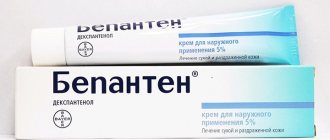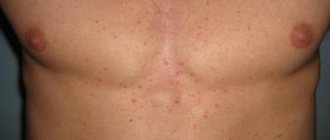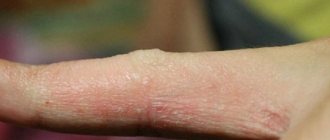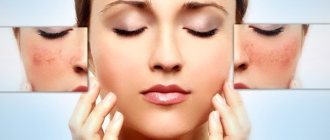Symptoms of a mosquito allergy Diagnosis of a mosquito allergy Treatment How to avoid mosquito bites What to do after a bite What to smear on a bite Repellents - protection from mosquitoes How to use repellents
We also got to our smaller friends - mosquitoes. Allergy to mosquitoes is an interesting and fascinating topic. If only because an allergic person can react not only to mosquito bites, but also to particles of the insect’s body.
Mosquito particles are airborne and contain volatile allergen proteins. The most studied of the mosquito's volatile proteins is Tropomyosin, which causes cross-allergic reactions with arthropod tropomyosins.
To catch a mosquito protein, it is not necessary to encounter an insect; it is enough to swim in a lake or cut up fresh freshwater fish.
Mosquito allergy is a type of insect allergy (Insecta - insects) and is called Culicidosis.
If you are allergic to, for example, birch, this does not mean that you will necessarily have a reaction to insect bites.
But if an allergy to mosquitoes has already developed, there is a risk of developing allergies to other insects.
Interestingly, people with atopic dermatitis are more likely to develop insect allergies. Probably because the protective function of atopic skin is impaired and allergens easily penetrate through it.
Biologists consider mosquitoes to be non-biting insects, like butterflies, bedbugs, lice, fleas and cockroaches. Proteins from some insects can cause cross-allergic reactions. For example, if there is a reaction to a cockroach, then there may be a reaction to grasshoppers and house dust mites.
And here’s another little-known fact: mosquitoes love the blood of animals - rats, artiodactyls, and human blood, with all due respect, is like cancer for them without fish. Human blood is poor in the substance necessary for the formation of mosquito eggs - the amino acid isoleucine.
In places inhabited by people and other animals there are usually not many, so mosquitoes have no choice - they have to bite us.
If you think that a mosquito pierces the skin of a mammal with its proboscis, then you are mistaken. I was wrong too.
The mosquito has plenty of other weapons. With its proboscis, the insect examines the skin, looking for a suitable place to bite. What places do mosquitoes like most? This is still a mystery to scientists.
When a suitable place on the victim's body is found, the mosquito pierces the skin with its mandibles (mandibles), then uses them as spacers to prevent the edges of the wound from meeting.
Then the mosquito plunges its lower jaws, like sharp saws, into the wound and saws it. And only after this, the mosquito inserts two needles into the wound. Through the first it sucks out the blood, through the second it injects saliva with an anticoagulant, which prevents the blood from clotting.
Mosquito saliva contains allergenic proteins, to which allergic reactions most often occur. Scientists have thoroughly studied 12 proteins in mosquito saliva.
Symptoms of a reaction to a mosquito
There is no reaction to the first mosquito bite; it appears to subsequent bites. If the immune system is in order, then the body reacts less over time to the same type of mosquito - the principle of vaccination.
If the reaction to a bite is allergic, then it will not weaken with age. The more an allergic person is exposed to mosquitoes, the stronger the reaction will be.
Reactions to a mosquito bite can be divided into several types:
- normal reaction;
- allergic reaction;
- dangerous allergic reaction.
Symptoms of a normal reaction
- The bite site turns red, swells, and an itchy pimple appears;
- in people with sensitive and thin skin, the bite site may turn blue. The blueness fades over time;
- symptoms disappear after 7 - 11 days.
A normal reaction is not dangerous. Itching causes trouble: due to scratching, the wound can become infected and you will have to apply antibiotic ointment.
Allergic reaction
- The bite site swells greatly - the diameter of the swelling can easily be more than 10 cm;
- swelling at the site of the bite lasts from several hours to several weeks;
- the wound hurts, itches very much, becomes warm or hot to the touch;
- rash at the site of the bite;
- hives;
- Skeeter's Syndrome may develop (very large swelling, when the site of a mosquito bite swells, expands and hurts, like a wasp sting. Blisters appear at the site of the bite, and the temperature rises);
- diarrhea;
- vomit;
- stomach ache;
- bronchospasm;
- sweating;
- dry mouth;
- chills
- sometimes the temperature rises (especially if there are a lot of bites);
- malaise;
- lymph nodes may become enlarged;
- insomnia.
Keep in mind that if a mosquito bites a small child or adult in a sensitive place - eyelid, lip, forehead, temple - the reaction may be strong, but not allergic.
If symptoms of a severe reaction occur after each mosquito bite, or the reaction gets worse, then it's time to visit an allergist.
Symptoms of a dangerous allergic reaction
We urgently call an ambulance!
- Swelling, redness, itching spread throughout the body beyond the bite - a leg was bitten, and the face began to swell;
- dizziness, nausea and vomiting;
- severe hoarseness of voice;
- it becomes difficult to breathe;
- you feel dizzy and feel like you are about to faint.
If there have been cases of anaphylactic shock, always keep adrenaline and an emergency phone number on hand. European pharmacies sell EpiPen and Anapen Jext adrenaline pens. Learn to use the auto-injector ahead of time and know your dosage.
In case of anaphylaxis, adrenaline is needed. Hormones - prednisolone or dexamethasone are used for urticaria. The dosage should be checked with your doctor.
Story. Allergy to insect bites
Who is most likely to have insect allergies? Is it true that a reaction can begin even without a bite? And what to do if this happens to you? All the answers are here.
Insect allergies occur upon contact with insects, and not only from bites: sometimes it is enough just to touch them or inhale their waste products¹.
2%
Allergies to insects are common² among the population, and in some countries the figure reaches 4%.
The situation in Russia is more favorable: in different regions the prevalence ranges from 0.1 to 0.4%².
The most dangerous are stinging insects, especially wasps and hornets, which can attack for no apparent reason. They behave most aggressively in August and September. Bees and bumblebees usually do not attack themselves; If you don't provoke them - don't wave your arms or run after them with a fly swatter - they probably won't touch you². Non-stinging insects can also cause an allergic reaction. Allergies are often caused by blood-sucking insects, such as mosquitoes³. But non-biting insects (butterflies, bloodworms) are relatively harmless. However, we must remember that an allergic reaction may develop upon contact with them. Thus, owners of aquarium fish who feed insect food to their pets may develop a reaction to bloodworms, which is manifested by symptoms such as cough, conjunctivitis, nasal congestion and rhinorrhea¹,³.
Statistics show that allergies to stinging insects are more common at a young age. Half of allergy sufferers are under 20 years of age, and 38% of insect allergy sufferers are under 12 years of age⁴.
“Since I was five years old, I have been allergic to bee stings,” says Grisha Melkonyan, a financial analyst. “It all started when my parents sent me to my grandfather for the summer; he has his own apiary near Yerevan. I was curious what the bees were doing in the houses, I wanted to touch them and play, but my grandfather forbade them. One morning, while everyone was sleeping, I finally made it to the house. But the joy was short-lived: a bee bit me on my left cheek. I got scared and went to wake up my grandfather. He was in shock: his cheek was very swollen and red. We immediately went to the hospital, where I was diagnosed with an allergy. Since then, I have tried to stay away from bees, and if they do bite, I quickly remove the stinger from the wound, rinse it with cold water and take an antihistamine. Usually the bite site becomes red and swollen, and the temperature rises². Most often it goes away on its own within a day, but several times I was even taken to the hospital.”
An allergy can be to individual insects, for example only to bees, or it can be to several species at once, then wasps, bumblebees and other insects can be added to bees⁴.
“It’s funny, I’m only allergic to midges,” says producer Nadezhda Markelova. “And I discovered it at the age of 20 (now I’m thirty). This was a surprise. I have always loved hiking; no horseflies or mosquitoes scared me. But the midge became a problem. She overtook me in an eco-camp near Noginsk, bit me on the eyebrow, and three hours later my eyelid swelled. The next morning I couldn’t even open my eyes. Then I encountered midges in Karelia, but I already knew that I needed to take repellent with me. From personal experience, I will say that vanillin solution repels mosquitoes best.”
What happens with allergies
Symptoms of insect allergies depend on the type of insects, which can be divided into two groups²,³:
Stinging (wasps, bees, bumblebees)
Their venom contains substances that increase vascular permeability and cause pain. Plus, when hymenoptera bites, they inject toxic substances, and the high-molecular proteins that make up the poison can cause an allergic reaction with characteristic symptoms: from swelling of the bite site to fever, suffocation and loss of consciousness².
Non-stinging
- Blood-sucking insects (mosquitoes, horseflies, midges). According to statistics, every fifth person develops an allergy to the bites of blood-sucking insects (approximately 17–20%). They most often cause skin allergic manifestations. Less commonly, the reaction to bites is manifested by headache, fever and bronchospasm².
- Non-biting insects (moths and butterflies). The reaction occurs upon contact with proteins in their bodies, and symptoms (rashes such as urticaria) may not appear immediately after contact, but after a while³,⁵.
How to treat insect allergies
The reaction to insects can be systemic and local. In the first case, the whole body responds to the allergen with nausea, fever, headache, and sometimes bronchospasm and swelling of the larynx. In the second case, symptoms appear on the skin and mucous membranes in the form of local redness, blisters and swelling ²,³.
A local reaction can be treated on your own. First, rinse the affected area with water and, if possible, treat it with an antiseptic (hydrogen peroxide, alcohol). Make a cold compress: simply wrap an ice cube in a cloth. Important point! If you are stung by a bee, be sure to remove the sting with a needle. Removal with tweezers or fingers is undesirable, since it is possible to squeeze out the poison from the reservoir of the insect’s venom gland remaining on the sting⁶.
Do you have a first aid kit on hand? Treat the bite site with a topical medication that relieves local allergy symptoms: redness, itching and swelling⁷.
After a bite, you should take antihistamines for 3–5 days².
In case of a systemic reaction - swelling, asthma attacks - urgent medical attention is needed. As a rule, people with severe allergies are aware of their problem and are always prepared for an emergency. An action plan is drawn up by a specialist. Usually it’s like this: immediately apply a tourniquet above the bite site for 20 minutes⁴,⁶ and inject an adrenaline solution. Further tactics will depend on the severity of the symptoms⁶.
Other ways you can protect yourself:
Stinging insects love flowers, so wearing brightly colored clothing with patterns is not a good idea.
It is safest to wear white clothing. Perfumes with notes of flowers and sweets should also not be used.
If you're on a picnic, cover your food with a towel or napkin so as not to provoke insects.
Don't kill Hymenoptera. They emit a smell that mobilizes their relatives and increases the chances of new attacks.
If you or your relatives have ever had an allergy to insects, with the help of a doctor, select an emergency remedy and always carry it with you.
Text: Anastasia Vasilyeva
Illustrations: Nina Magradze
Diagnosis of mosquito allergy
Correctly identifying an allergic reaction is not easy. Especially if you make a diagnosis without the help of an allergist or dermatologist.
Mosquito bite rash can be confused with prurigo rash or toxic rash that affects people with autoimmune diseases. In addition, the cause of the rash may be an infection, the causative agent of which entered the body with the saliva of an insect.
Therefore, if you suspect you are having an allergic reaction, rush to see an allergist. The doctor will examine, listen and, possibly, prescribe additional examinations.
Algorithm for diagnosing allergies:
- The allergist must establish a connection between the clinical manifestations of the reaction and the bite - the clinical picture;
- positive skin tests with extracts from the insect body. In Russia, reagents with the mosquito allergen Aedes aegypti are used;
- there must be IgE antibodies to the mosquito in the blood;
- provocative tests (not officially allowed in Russia).
There is no point in taking specific immunoglobulin G (IgG) for mosquito allergens. A positive analysis only confirms the fact that the body has already encountered proteins - allergens.
Remember the time the reaction began, its duration, symptoms and sensations after the bite - this will help the doctor draw the right conclusions.
I found interesting information on the UpToDate website: it is not always necessary to perform skin tests or take a blood test for specific immunoglobulin E (IgE) to mosquito saliva.
The reagents used in the research contain very little mosquito saliva, but a lot of other irritating proteins. These proteins may give a false positive result.
I think you will find laboratories that offer mosquito saliva testing, such as the ImmunoCap (Phadia) method. However, it is better not to take the test without a doctor’s referral and his help in interpreting the result.
You can conduct provocative tests - they are considered the most reliable, but doctors rarely perform them, since during the test an allergic person may have a serious reaction. In Russia, such tests are not certified, in other words, they are prohibited.
Skin application tests (Patch test) are also prohibited in our country. Abroad, such tests are carried out with insect extracts if contact dermatitis is suspected.
Treatment
Symptomatic treatment
- Relief of allergy symptoms with 2nd generation antihistamines (in age-appropriate dosage): cetirizine, loratadine, desloratadine. The duration of the appointment is prescribed by the doctor.
- Normalization of the general condition with glucocorticosteroids: pulmicort, nasonex.
- Application of antipruritic creams.
Preventative treatment
- If it is not possible to avoid mosquito bites, your doctor may prescribe antihistamines for as long as the insects are active.
- Use repellents.
Immunotherapy ASIT
Fortunately, mosquito bite allergies can be treated with immunotherapy. However, like allergies to bee and wasp stings.
Timely ASIT helps reduce the body's sensitivity to mosquito allergens and improves the quality of life of an allergy sufferer, reducing the level of fear of insects
ASIT is carried out in autumn and winter for 3 - 5 years. For therapy, an extract of mosquito bodies is used.
Unfortunately, mosquito allergies are not officially treated in Russia.
But specialists from the State Scientific Center of the Russian Federation - Institute of Immunology of the FMBA - have created a medicinal form of a water-salt extract of the mosquito allergen Aedes Aegypti. Now scientists are waiting for the official registration of the drug.
Abroad, mosquito allergies are well treated with medications, both in tablets and injections.
When is ASIT prescribed?
- if a true allergy to mosquitoes is confirmed;
- increasing violent reactions to bites (severe systemic reactions);
- respiratory symptoms worsening year after year;
- Allergy sufferers have a strong fear of insects.
While domestic medicine cannot offer treatment methods, allergy sufferers are left with only prevention.
What does a fly bite look like photo
Autumn flies bite humans and farm animals on the legs, and dogs and pigs on the ears. Mechanical damage to the skin becomes possible due to the presence of a proboscis with a thickening in the autumn zhigalka, which in appearance resembles a sting. This device allows individuals to easily bite through the thick skin of farm animals.
The picture of what a fly bite looks like in a photo and the symptoms depend on the species of the insect and the individual characteristics of the person. In most cases, the reaction to the toxic components of saliva is limited to redness of a small area of skin around the wound and slight swelling. Inflammation of the lymph nodes, multiple lesions of the body, and suppuration occur in rare situations. They are typical for people with hypersensitivity and young children with delicate skin. The consequences of a fly attack resemble mosquito bites in appearance: a red dot at the site of the skin puncture and local redness.
How to avoid mosquito bites
The best way to avoid being bitten is prevention. If you are going on vacation to warm regions, remember that in hot countries mosquitoes carry dangerous infections.
- go around parks, forests, ponds and swamps;
- and of course do not swim in ponds with standing water;
- install mosquito nets on windows. Just don’t leave your child alone in a room with an open window;
- use mosquito nets for baby strollers;
- fumigators (not recommended for use if there is a child under 2 years old at home);
- ultraviolet, electric or carbon dioxide mosquito traps (for example: Swissinno SWI-20 or EcoSniper GF-4WB);
- wear the most closed clothing made of thick fabric;
- use repellents. Before going outside, treat your clothes with special impregnations, lotions, sprays;
- do not wear clothes of bright colors - insects can distinguish them;
- in hot weather, do not wear dark-colored clothes, you will sweat more in them, and mosquitoes focus on high concentrations of carbon dioxide;
- in the evening try to stay at home. In the dark, mosquitoes become more active;
- remove all standing water: buckets, barrels. Unfortunately, the pond will also have to be filled in;
- inspect basements and attics, there may also be standing water there;
- if you can’t handle it yourself, call specialists who will carry out disinfestation of the suburban area;
- always take with you an antihistamine and an allergy passport or bracelet;
- if you react violently to bites and you can’t escape from mosquitoes, then take antihistamines and keep adrenaline in your first aid kit and an emergency phone number in your notebook. Be sure to check the expiration date and follow the storage conditions of medications.
How to treat insect bites at home
A healthy body reacts quite mildly to insect bites, so they can easily be treated at home.
- First remove the sting if it is stuck in the skin;
- Treat the affected area with alcohol or alcohol-containing cologne;
- Immediately apply an ice pack or something cold to reduce swelling.
However, with insufficiently developed immunity (for example, against bee venom), the bite site will still swell and irritate. Most likely you will need to take painkillers and apply antihistamine ointment.
What to do after a bite
Please discuss any medications with your doctor.
- Wash the bite site with cold water and soap and treat with an antiseptic: chlorhexidine, octenisept, miramistin.
- Apply ice or something cold (through a towel) to reduce swelling.
- Itching can be relieved with antipruritic creams: Calamine, Tsindol, Poksklin. Don't be afraid to apply the cream as often as you want - it won't get any worse. It is better not to scratch the wound. Trim your child's nails, and at night you can put on thin gloves for him so that he does not scratch the bite in his sleep.
- Antihistamine ointments (allergosan, etc.), drops and ointments with zinc are good for relieving itching. I use Zodak or Suprastinex drops. Just remember that antihistamine ointments increase skin sensitivity to the sun. Zinc ointment and antihistamine ointment can be combined.
- If there is no ointment, you can apply a soda lotion to the bite site: 1 teaspoon of soda per glass of water. For 15 minutes.
- Doctors do not recommend traditional therapy: rub the bite with parsley, a basil leaf, apply a cabbage leaf, earth, plantain or gauze with urine. The risk of infection or allergic reaction is too great.
- If there are a lot of bites, severe swelling or itching interferes with sleep, take a 2nd generation antihistamine for 5-7 days: cetirizine, loratadine, desloratadine, in an age-appropriate dosage.
- It is recommended to use one thing: either oral antihistamines or topical antihistamines.
- Hormonal ointments will help relieve severe itching and swelling: Advantan, Comfiderm. Usually doctors prescribe them in courses of 5-10 days.
- In severe cases, doctors may prescribe a course of prednisolone tablets;
- If a bacterial infection develops—yellow crusts, pus, and oozing appear at the site of the bite—antibiotics may be needed. The doctor will prescribe Baneocin, Bactroban, Fucidin, Oxycort, erythromycin ointment.
- When the bite is very painful or the temperature has risen, you will need an antipyretic: ibuprofen or paracetamol. For a child, the dosage of drugs is calculated by weight. Ibuprofen: 10 mg per 1 kg. Paracetamol: 15 mg per 1 kg.
- If there is severe swelling of the eyelid, consult a doctor. Your doctor will probably recommend dexamethasone eye drops. Try to drink more (not to be confused with “drink”











